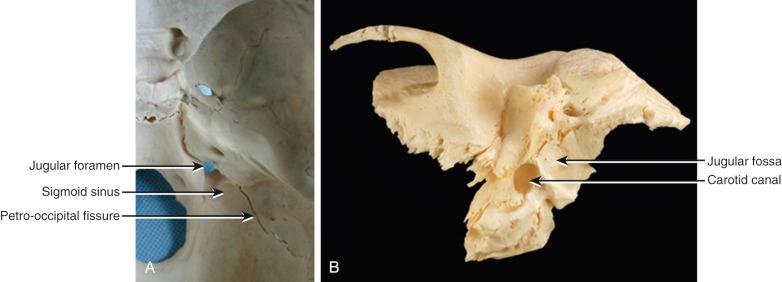Physical Address
304 North Cardinal St.
Dorchester Center, MA 02124
Progressive deficits of cranial nerves IX, X, and XI associated with pulsatile tinnitus and hearing loss are the most common presenting features of jugular foramen tumors.
The differential diagnosis of jugular foramen tumors is highly reliant on magnetic resonance and computed tomography imaging.
Although paragangliomas and schwannomas are the most common intrinsic tumors that arise in the jugular foramen, numerous other tumor types must be considered when making a diagnosis.
Assessing for the possibility of a tumor predisposition syndrome and the need for genetic screening of the patient's pedigree is now a standard of care for patients with paragangliomas.
Management protocols for patients with paragangliomas and schwannomas include clinical observation with interval scanning, stereotactic radiosurgery, and surgical resection. There are specific indications for each of these treatment modalities.
Preoperative assessment of the cerebral circulation and embolization of the tumor are vital steps in the surgical management of patients with paragangliomas.
Sometimes described as a complex neurovascular crossroad at the posterior skull base, the jugular foramen is a large opening situated between the temporal and occipital bones midway along the petro-occipital fissure, above and lateral to the foramen magnum ( Fig. 49.1A ). It is usually larger on the right side than on the left, reflecting the right dominance of the sigmoid sinus and jugular vein. Immediately adjacent and slightly anteromedial to the jugular fossa at the skull base is the opening of the carotid canal ( Fig. 49.1B ).

By convention, but confusingly, the jugular foramen is divided into two compartments: an anteromedial pars nervosa and a posterolateral pars vascularis. Both of these “pars” contain nerves and blood vessels, so a strictly anatomic description that defines the larger posterolateral compartment as the “sigmoid part” and the smaller anteromedial compartment as the “temporal part” is far more accurate. The anteromedial compartment contains the glossopharyngeal (IX) nerve and its branch, the Jacobson nerve, together with the more medially placed inferior petrosal sinus. It is separated by a fibrous septum from the larger posteromedial compartment that contains the internal jugular vein laterally and, from anterior to posterior, the vagus (X) nerve, posterior meningeal artery, spinal accessory (XI) nerve, and a branch of the vagus, the Arnold nerve. Cranial nerves IX, X, and XI pass through the jugular foramen in a connective tissue sleeve that attaches the dura to the pericranium extracranially and is penetrated by the inferior petrosal sinus between the ninth and tenth nerves.
A large spectrum of tumors may develop in and around the jugular foramen, and this has prompted a classification according to whether the tumor has developed from tissues intrinsic to the foramen or from tissues outside of it.
Paragangliomas and nerve sheath tumors, schwannomas, predominate, followed by meningiomas. In the elderly, metastases from primary bronchial, breast or prostatic tumors are most common. Perineural spread from squamous cell malignancies of the face and oral cavity should always also be considered as lymphoma and melanoma. The jugular foramen is also a site where primitive neuroectodermal tumors (PNETs) can develop.
This is a diverse group of tumors most often of temporal bone origin—for example, endolymphatic sac tumors, carcinoma, chondrosarcoma, or chordoma. Occasionally, glial tumors or a hemangiopericytoma will destroy the jugular foramen from above or a rhabdomyosarcoma infiltrates it from the deep fascial spaces below the temporal bone.
No matter whether of intrinsic or extrinsic origin, all of these tumors produce deficits to cranial nerves IX, X, and XI characteristic of a jugular foramen syndrome. The order in which these deficits develop and their associated symptoms and signs—for example, pulsatile tinnitus, conductive or sensorineural hearing loss, Horner syndrome, or hemilingual wasting—gives further information about the likely extent of the tumor and possibly its nature.
Nowadays, the diagnosis is largely made on the basis of imaging characteristics using a combination of magnetic resonance imaging (MRI), computed tomography (CT), angiography, and positron emission tomography (PET). This has revolutionized the management of this group of patients and has allowed them to avoid a number of unpleasant and potentially complicated procedures—for example, a biopsy.
At an early stage in development, jugular paragangliomas erode the jugular spine that lies between the jugular fossa and entrance to the carotid canal and later produce a characteristic “moth-eaten” pattern of bone destruction in the temporal bone, best seen with high-resolution, thin section, axial CT images ( Fig. 49.2A ). In contrast, schwannomas produce a scalloped but well-corticated enlargement of the jugular foramen on bone-windowed CT ( Fig. 49.2B ). The characteristic MRI appearances of paragangliomas are those of a highly vascular tumor with flow voids that give the “salt and pepper” appearance that is so often described ( Fig. 49.2C ). MRI also provides more detailed information on intraluminal tumor propagation down the internal jugular vein or along the sigmoid and lateral sinuses and invasion of the internal carotid artery (ICA). Schwannomas produce low signal, isointense with brain on T1-weighted images ( Fig. 49.2D ), high signal on T2-weighted images, and moderate contrast enhancement. They may contain cystic areas and have peripheral flow voids that represent their vascular supply.

Become a Clinical Tree membership for Full access and enjoy Unlimited articles
If you are a member. Log in here